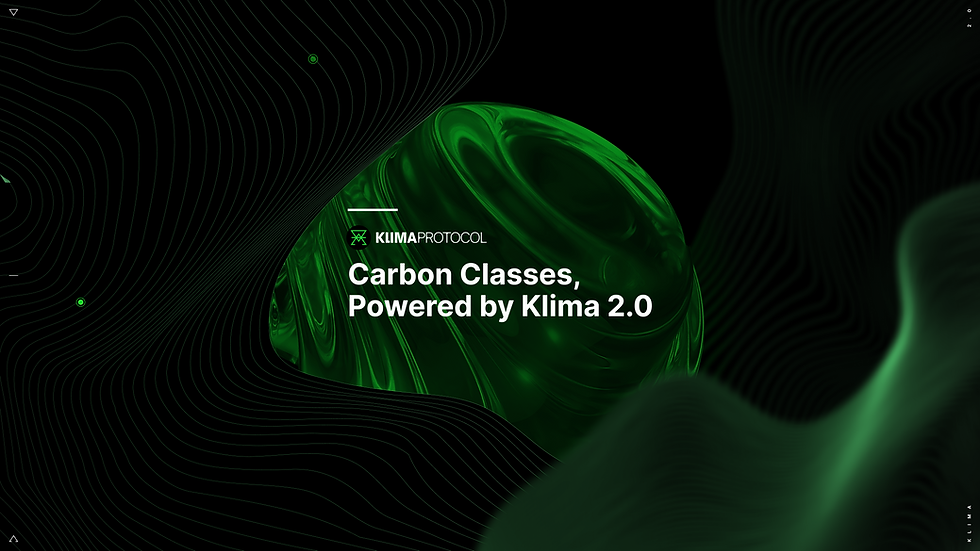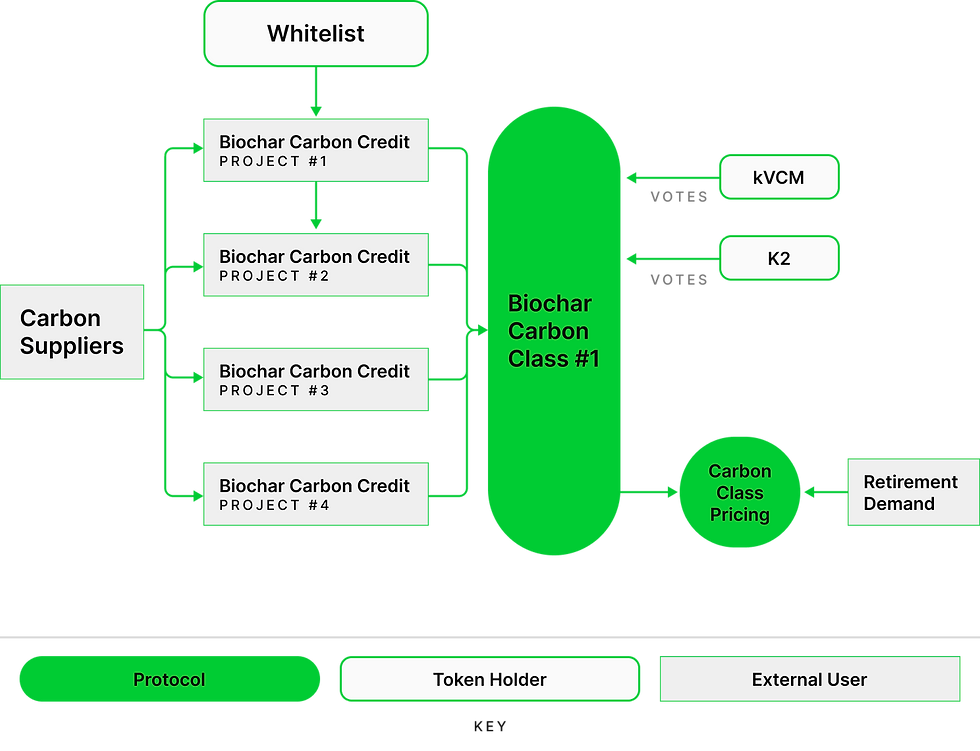Introducing Carbon Classes: A New Era of Onchain Carbon Markets
- Klima Protocol
- Jul 10
- 4 min read
Updated: Jul 10

How Klima Protocol is Standardizing Carbon Credit Markets for Greater Transparency, Access, and Impact
Introduction: Why Carbon Classes Matter
In the traditional voluntary carbon market, no two credits are exactly alike. Each credit is tied to a specific project, methodology, registry, and vintage. While this uniqueness offers rich traceability, it also fragments the market, making it difficult for buyers to compare prices, assess quality, or build diversified portfolios. Liquidity suffers. Trust erodes. Scale stalls.
Enter carbon classes — a transformative concept designed to bring order to complexity. With Klima Protocol’s token architecture, carbon classes group credits with similar characteristics into standardized pools, while still enabling individual credits to be retired. The result is transparent price discovery, improved access, and composable infrastructure that makes carbon markets programmable and efficient.
What Are Carbon Classes?
Carbon classes are a curated group of carbon credits that share essential features such as technology type, crediting methodology, and durability. For example, credits from biochar projects, with high permanence and specific co-benefits, can be grouped together in a class such as CHAR. The same principle applies across other technologies like ocean alkalinity enhancement (OAE), afforestation and reforestation (ARR), and renewable energy avoidance projects (RNWBL).
Instead of treating each credit as a one-off, classes provide a way to compare similar credits, enabling reference pricing and smoother integration into digital systems. Eligible projects are whitelisted through community governance, and once approved, their credits are tokenized and integrated into active pools with live trading, price feeds, and smart contract support.
Carbon Class Identification Table
Carbon Categories | Carbon Class |
Carbon Dioxide Removals | OAE Ocean Alkalinity Enhancement |
ERW Enhanced Rock Weathering | |
BCHAR Biochar | |
Forestry | REDD Reducing Emissions from Deforestation and Forest Degradation |
ARR Afforestation, Reforestation, Revegetation | |
IFM Improved Forest Management | |
Blue Carbon | MNGRV Mangrove Restoration |
Carbon Dioxide Avoidance | RNWBL Renewable Energy |
COOK Cookstoves | |
LFG Landfill Gas |
*Names and carbon classes composition may still change prior to the initial launch.
Why Carbon Classes Are Essential
Standardizing carbon credits into classes brings crucial benefits. Price transparency becomes possible as trades within each class continuously update a shared reference point. This allows buyers to evaluate cost and quality across comparable credits. It also makes portfolio design much more practical. Organizations can mix classes based on permanence or co-benefits — for example, combining REDD credits with CHAR or OAE to balance cost with long-term impact.
Moreover, as carbon classes are based on programmable smart contracts, climate finance automation opportunities are enabled. Klima Protocol's onchain infrastructure leverages smart contracts to automate credit retirement in response to third-party events, such as emissions disclosures or other transactional triggers. Behind it all is a governance model that keeps the system accountable.
How Klima’s Token Engine Powers Carbon Classes
Klima Protocol runs on a dual-token system. The $kVCM token serves as the liquidity layer, used to stake, vote, and provide capital for trading pools. The $K2 token represents equity and incentive mechanisms, earned through active participation in the system.
When a project applies to join a class like BCHAR, it goes through advisory and market stakeholder review process. If approved, its credits are whitelisted and made available for trading within the class pool. Liquidity providers deposit both the credits and $kVCM into a shared pool. As trades occur, real-time price data flows into the protocol’s oracle, which updates benchmarks used by other systems.
This architecture transforms carbon credits from passive commodities into programmable, liquid assets that can interact with broader ecosystems.
Who Benefits from Carbon Classes?
For token holders, carbon classes offer opportunities to earn from liquidity provision, swap fees, and governance incentives. By participating in curation, holders directly influence which projects define the climate finance landscape.
Project developers benefit by gaining visibility and a clear price reference, which supports fundraising, MRV partnerships, and long-term viability. Being part of a recognized (whitelisted) carbon class signals trust and performance.
Corporates and apps developers gain predictable, high-quality credit sources. Through Klima’s ecosystem, companies can integrate automated offsetting, manage risk exposure, and ensure alignment with sustainability goals.
Spotlight on BCHAR: The Biochar Carbon Class
One of the most promising carbon removal pathways is biochar. This process transforms biomass into a stable, carbon-rich substance through pyrolysis. Once applied to soil, biochar locks away carbon for centuries, while also improving water retention, nutrient efficiency, and soil fertility.

BCHAR is Klima Protocol’s first fully active carbon class. It includes credits from Exomad Green and Skyeast, both of which have undergone procurement. The durability of BCHAR credits is typically over 100 years, verified through standards such as Puro.Earth and ICR. Beyond carbon storage, BCHAR projects often contribute to regenerative agriculture and circular waste management.
Conclusion: Building a Smarter Carbon Market
Carbon classes are more than a new way to organize credits — they are foundational tools for building scale, trust, and efficiency in climate finance. By shifting from one-off trades to structured pools, Klima Protocol is helping carbon markets become more transparent, accessible, and programmable.
Whether you're a developer launching a carbon removal project, a corporate buyer looking to offset emissions with confidence, or a stakeholder shaping the next generation of climate infrastructure, the class system gives you tools to participate, influence, and scale impact.
Now is the time to get involved: stake, vote, build.






Comments